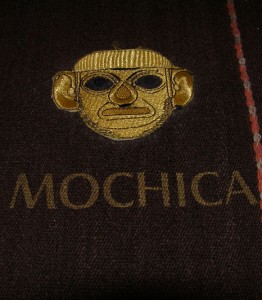
Mochica menu
Mochica
3863 St. Denis Street (between Duluth Street and Roy Street)
Montreal, Quebec H2W 2M4
(514) 284-4448
www.restaurantmochica.com
Hours: Tues: 5-10 p.m.; Wed-Sat: 5-11 p.m.; Sun: 5-10 p.m.; Closed Mon.
Vegetarian-friendly
Average for meal/person, excluding wine, taxes, and tip: $20-$40
Major cards and Interac
Rating: ◊◊◊◊ (excellent)
There is always something exciting about wining and dining at a restaurant that offers non-traditional or exotic cuisine. Most people are familiar with the popular international cuisines such as Italian, Japanese, and Indian. But what if someone mentions Peruvian?
Peruvian cuisine, which is influenced by the Mochica and Incas heritages and later by Spanish, Basque, African, Sino-Cantonese, Japanese, and finally Italian, French, and British immigration, synthesizes the flavours of four continents.
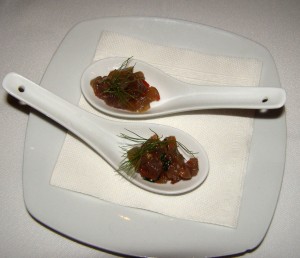
Red tuna with Peruvian pepper and dill
My recent dining experience at Mochica, named after the ancient Peruvian civilization—very little was known about the opulent and sophisticated Moche civilization until a heist incident initiated the archaeological discovery in the late 1980s—was like a discovery of a culinary treasure hidden in the heart of the Plateau area in Montreal, a discovery of refined traditional and contemporary Peruvian cuisine. As you enter the inviting restaurant, you are greeted with a black, off-white, and warm red décor setting. You will also notice an archaeological find of reproductions of Mochica art, including a splendid sculpted stone art work on one of the walls, tastefully displayed in the museum-like dining room. As you continue to explore the room set under gallery-like lighting, you will slowly discover white painted words on the glass panel of the wine cellar and on the central black square pillars. Simple and elegant, the interior design mixes traditional and contemporary elements, a reflection of the type of dishes to be found in the restaurant’s menu.
The menu is representative of the largely eclectic variety of Peruvian dishes. And many of the ingredients, including the herbs and spices, are imported from Peru. With the help of the hospitable and informative co-owner-maître d’-waiter Claude Petrin, my dining companion and I opted to share a main dish, a dessert, and a three-course table d’hôte of the evening. We snacked on complimentary canchita, salted roasted maize kernels, as we waited anxiously for the co-owner-chef Martin Oré to prepare our selected dishes.
We began the meal with a delightful amuse-bouche served in Asian spoons. The ceviche of red tuna morsels was enhanced with Peruvian pepper and garnished with dill. A lovely start to what was to come from the kitchen.
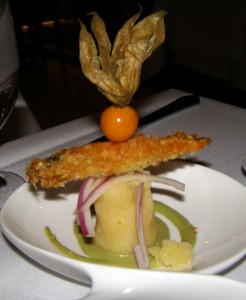
Fried breaded herring fish
We were both in an adventurous mood so we settled on the “trio spontanée du chef” as the appetizer. Artistically and beautifully presented on a trio plate, the trio creation of raw, grilled, and fried seafood was pleasing not only to the eye but also to the palate. On one of the adjoining plates, the ceviche of chopped scallop, finely diced apple, and coriander was molded into a small column and doused in lime juice. Embellished with a tuft of baby greens and edible flowers, the assembled ceviche was refreshing, and even my dining companion, who was not a seafood/fish fan, enjoyed it immensely. In the middle of the plate presentation, a gorgeously grilled octopus tentacle was served with chimichurri sauce and accompanied with large corn kernels and a cut-out, flower-shaped turnip. Here the delicious components created an intriguing play of different flavours and textures. And then, there was the third adjoining plate of another food architectural construct. Above a swirl of green ají sauce, a fried breaded herring fish was arranged atop julienned red onions and a sculpted mound of Peruvian potatoes covered in Montecoso cheese. To complete the food structural art, a fresh gooseberry—a recurring ingredient in several of the sampled dishes—was fixed on top of the herring fish. The fish had a pleasant spicy kick from the accompanying sauce, and, as for the potato portion, it disappeared very quickly from the table.
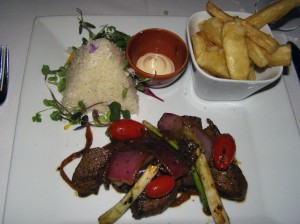
Lomo saltada—sautéed Angus beef with chapa pepper
The principal dishes proved to be even more stellar. My dining companion was in heaven with the “lomo saltada” dish. Succulent chunks of sautéed Angus beef with chapa pepper were accompanied with red and green onions, cherry tomatoes, asparagus spears, and ají escabeche and served with a pyramid-shaped pile of rice, crispy cassava fries, and homemade rocoto mayonnaise. Equally impressive was the “pez espada a la parrilla”; the dish was not only nutritious; it was also absolutely scrumptious. Grilled to medium-rare perfection, the melt-in-your-mouth swordfish marinated in chimichurri was served with a thick pepper-and-Pisco sauce enriched with seafood. And the accompanying sweet-potato mousseline, red peppers, asparagus spears, and black quinoa complemented the fish dish exquisitely.
During our main course, Claude offered us a taste of three Peruvian-hot-pepper-based sauces—a cheese sauce, an orange sauce, and a red one which Claude described as a sauce “for those who want to live dangerously.” The cheese ají sauce added a delightful pizzazz to the already flavourful cassava fries. My dining companion and I also enjoyed the spicy quality of the orange sauce and, particularly, the red sauce which quickly vanished in record time.
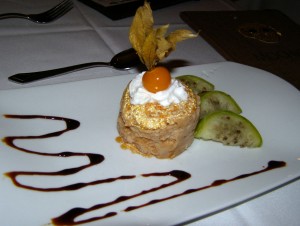
Merengueado de lúcuma—meringue cake with an Andean twist
We had high expectations of the next course of the meal, and we were not disappointed. The “merengueado de lúcuma” was a meringue cake with an Andean twist; made with lucúma mousse, the toothsome, fruit-accented cake was accompanied with a long, artistic zigzag of corn reduction syrup, slices of fresh green cactus pear, and yet another fresh gooseberry. However, the highlight of the final course was the “mazamorra morada.” Popular at Peruvian homes, this traditional Peruvian dish is rarely found in restaurants in Peru since it is reputed as street food. Under the culinary skills of chef Oré, the dish is elevated into an upscale and elegant dessert. Paired with a light round cookie made from quinoa flour, Oré’s dish was served hot, unlike the traditional version, which is served cold. Presented in a martini glass and decorated with a fresh gooseberry, the confiture-like purple corn pudding filled with dried apricot, pineapple, apple, prunes, and grapes was seasoned with cinnamon and cloves. It was simply divine.
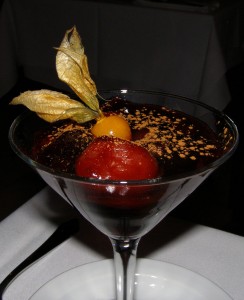
Mazamorra morada—purple Inca corn pudding filled with dried apricot, pineapple, apple, prunes, and grapes
Throughout the meal, the one-man show of Claude in the dining room was professional and solicitous. The excellent and friendly service combined with the spectacular dishes created from fresh local and foreign produce and ingredients and prepared by the amazingly talented Peruvian chef made my dining experience at Mochica so wonderful that I had to find another occasion to return to savour other delectable creations.
So during another visit to the restaurant, I opted to sample the “dia y noche.” Slightly infused with the Peruvian brandy Pisco and frosted with chocolate ganache that was dotted with chopped roasted pecans, the four-layer cake alternated with layers of vanilla and chocolate cake.
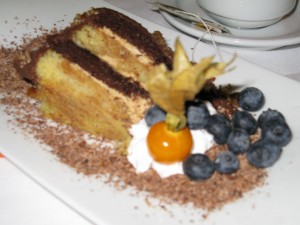
Dia y noche cake
The cake slice was paired with a dollop of Pisco-spiked crème de Chantilly and garnishes of fresh blueberries and gooseberry and encircled with a generous sprinkling of powder-like chocolate shavings. It was decadent. Not too sweet and not at all heavy. As I sipped slowly a glass of very smooth Pisco puro, I watched from a distance the other diners in the room enjoy their evening. Eager to return again, I look forward to dining and enjoying yet another Moche experience at Mochica, this time, to sample the llama and the highly anticipated delicacy of “cuy” or guinea pig. Now talk about being adventurous and courageous!
